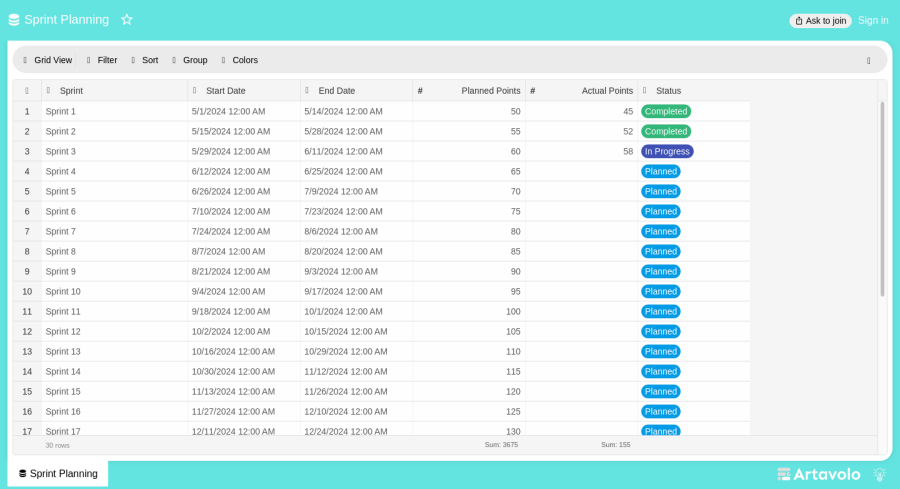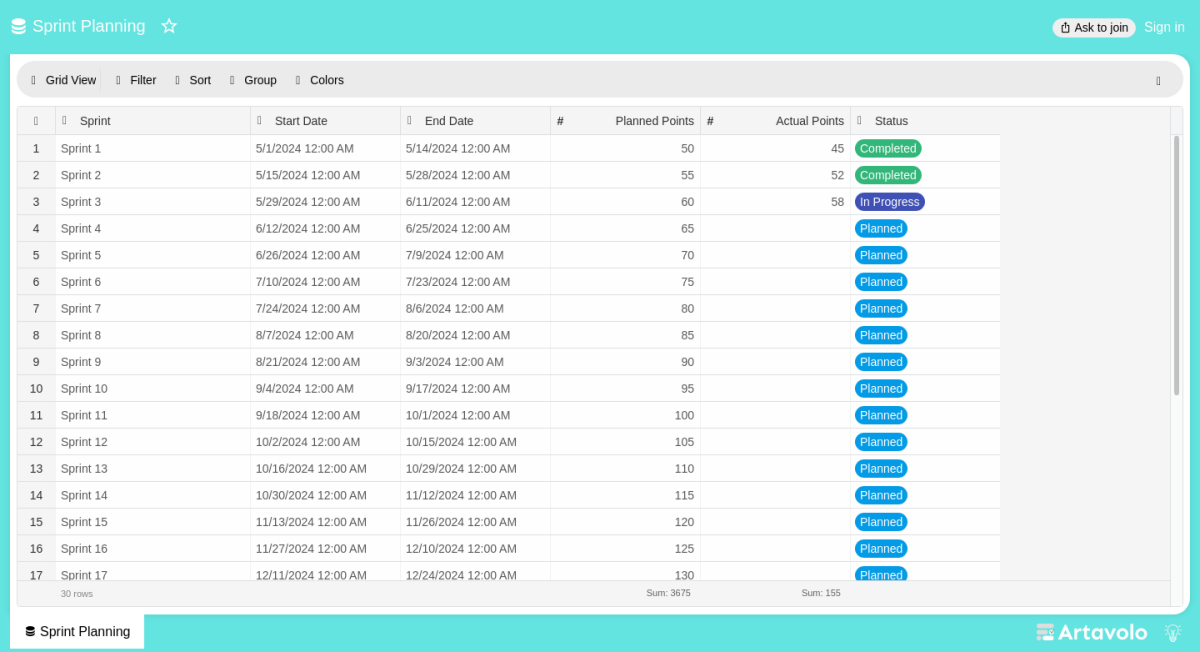In the world of agile project management, SCRUM stands out as a premier methodology for delivering high-quality products through iterative progress. Artavolo offers an array of features that align seamlessly with SCRUM, enhancing team collaboration, transparency, and efficiency. This blog post explores how you can leverage Artavolo’s specific features to implement and optimize SCRUM within your team, including the use of its dedicated SCRUM and project management templates.
Artavolo Features Tailored for SCRUM
1. Customizable Kanban Boards
Feature: Customizable Columns
Artavolo’s Kanban boards are highly customizable, allowing you to create columns that reflect your team’s specific workflow. For SCRUM, you can set up columns for different stages such as:
- Product Backlog
- Sprint Backlog
- To Do
- In Progress
- Done
This setup provides a clear visual representation of the sprint’s tasks and their current status.
2. Task Management
Feature: Task Cards with Detailed Information
Each task in Artavolo can be represented as a card containing detailed information such as descriptions, attachments, and due dates. This feature is essential for SCRUM as it allows team members to:
- Clearly define user stories and tasks during sprint planning.
- Attach relevant documents or images for better context.
- Set due dates to ensure timely completion within the sprint.
3. Prioritization and Backlog Management
Feature: Drag-and-Drop Prioritization
Artavolo’s drag-and-drop functionality makes it easy to prioritize tasks within the Product Backlog. During sprint planning, you can simply move tasks from the Product Backlog to the Sprint Backlog, ensuring the team focuses on the most critical tasks first.
4. Work in Progress (WIP) Limits
Feature: WIP Limit Settings
To maintain a steady workflow and avoid bottlenecks, Artavolo allows you to set WIP limits on columns. This feature ensures that the team doesn’t take on too many tasks simultaneously, aligning with SCRUM’s principle of sustainable pace.
5. Real-Time Collaboration
Feature: Real-Time Updates and Notifications
Artavolo supports real-time updates, meaning any changes made to the board are instantly visible to all team members. Additionally, notifications keep everyone informed about important changes, such as task assignments or status updates. This feature is crucial for maintaining alignment during daily stand-ups.
6. Progress Tracking and Reporting
Feature: Progress Indicators and Reports
Artavolo provides visual progress indicators and the ability to generate reports on task completion and team performance. These features are particularly useful for:
- Monitoring the sprint’s progress during daily stand-ups.
- Reviewing completed tasks during the Sprint Review.
- Analyzing team performance and identifying areas for improvement during the Sprint Retrospective.
7. Integration with Other Tools
Feature: Integrations
Artavolo integrates with various other tools commonly used in project management, such as Slack, Trello, and Google Drive. These integrations ensure that your team can seamlessly connect their SCRUM workflow with other platforms, enhancing overall productivity and collaboration.
8. Retrospective Notes and Action Items
Feature: Notes and Checklists
After each sprint, SCRUM teams conduct a Sprint Retrospective to discuss what went well, what didn’t, and how to improve. Artavolo’s note-taking and checklist features allow teams to document these insights directly on the board, creating action items that can be added to the next sprint’s backlog.
9. Role-Based Access Control
Feature: Permissions and Access Control
SCRUM involves different roles such as Scrum Master, Product Owner, and Development Team. Artavolo’s role-based access control feature ensures that team members have appropriate permissions, allowing for secure and organized management of tasks and workflows.
10. SCRUM and Project Management Templates
Feature: Pre-Built Templates
Artavolo offers pre-built templates specifically designed for SCRUM and general project management. These templates provide a ready-to-use structure that aligns with SCRUM practices, including pre-defined columns for Product Backlog, Sprint Backlog, To Do, In Progress, and Done. Using these templates, teams can quickly set up their boards and start working without spending time on initial configurations.
Implementing SCRUM with Artavolo: A Step-by-Step Guide
Step 1: Set Up Your Board
- Use Artavolo’s SCRUM template to create columns for Product Backlog, Sprint Backlog, To Do, In Progress, and Done.
- Customize swimlanes if needed to further organize tasks by team, priority, or any other criteria.
Step 2: Populate the Product Backlog
- Add user stories and tasks as detailed task cards.
- Prioritize tasks using the drag-and-drop feature.
Step 3: Sprint Planning
- Move prioritized tasks from the Product Backlog to the Sprint Backlog.
- Define the sprint’s goal and ensure all necessary details are included in the task cards.
Step 4: Daily Stand-Ups
- Use the board to quickly review the status of tasks.
- Update task statuses in real-time and discuss any blockers.
Step 5: Sprint Review and Retrospective
- Move completed tasks to the Done column.
- Review and demonstrate completed tasks.
- Use notes and checklists to document feedback and retrospective insights.
Step 6: Continuous Improvement
- Convert retrospective action items into tasks and add them to the Product Backlog.
- Adjust workflows and WIP limits as needed based on team feedback.
Conclusion
Artavolo offers a comprehensive suite of features that perfectly align with the needs of SCRUM teams. By leveraging Artavolo’s customizable Kanban boards, task management capabilities, real-time collaboration tools, progress tracking features, and pre-built SCRUM templates, teams can enhance their SCRUM practices and achieve greater efficiency and productivity. Whether you’re new to SCRUM or looking to optimize your existing process, Artavolo provides the tools necessary to succeed in today’s dynamic project environments.
Learn more about using Artavolo for Project management

